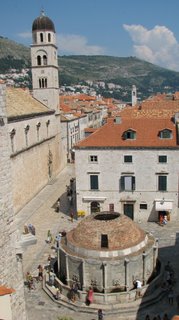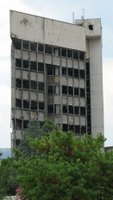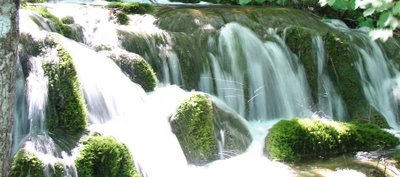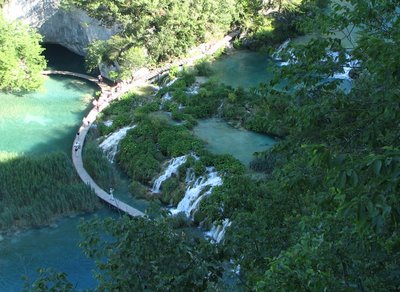Day 6 – Split to Dubrovnik By far the weirdest wake up in a long time with Bree licking my ears….followed by the best breakfast this week, which included rice pudding! We left the hotel just before 10am, bound for Dubrovnik; the mood turned sombre as we navigated along the busy route to Dubrovnik at a frustrating snails pace. The traffic was bordering on ridiculous, making a trip around London’s M25 feel like a daytrip; in the first hour, we had driven less than 30 kilometres.
It was clear that, like most places in the world, Croats are selfish drivers as some of the antics were nothing short of shocking. Imagine this: there’s a queue of motorists

as far as you can see and then some prick overtakes us all until forced to rejoin the queue he had left by oncoming traffic. Understandably, people don’t want to let deviants like these back in the queue which delays matters for both queues. Frustrated, we decided to turn off before reaching a town called Miz; according to the map, we had turned off onto a scenic/panoramic route, whatever that meant! In time, I realised I would some of my hubba-bubba gum to stifle my whimpers.
As we approached the small town Blato, a small forest fire raged in the distance. Over a period of two hours, we passed many isolated towns, which left you wondering what people do out here. We arrived at Vrgorac, quite close to the Bosnian border, but continued toward Metkovic; at this point, we were running low on petrol and, in Metkovic, we filled up with petrol. Nearby stood a significant road sign – to the left, you could go to Mostar and Sarajevo, significant locations from the Bosnian War while, taking the right, we continued our trip to Dubrovnik.
Ironically, the roads were much better this close to the Bosnian border: wider, allowing for overtaking, and in better condition. Back on the main road we had turn off from at Miz, we soon entered Bosnia via the cliff-top check-point. Just before 3pm, we passed the touristic town of Neum, Bosnia’s attempt at attracting a slice of the seaside tourist trade for itself in the small pass. Within minutes, we had re-entered Croatia. We heard a beep and, after checking his mobile phone, Bree had received a ‘Welcome to Bosnia’ text message. How odd!
We continued along the road to Dubrovnik, passing Ston, a salt-producing settlement protected by a 5.5km fortified wall, the longest in Europe. Shortly afterwards, we reached the Pejlesac Peninsula, the stretch of water which would be with us all the way to Dubrovnik. We had planned to take in the island of Korkula, visible over the water, but there just wasn’t time on this trip.
We reached Dubrovnik just after 4pm, crossing the huge white bridge which would lead us to street-after-street of palm tree-lined avenues, a true contrast to Zagreb in the north. I had to call the hotel as we had difficult locating them, but before long we pulled into the Hotel Komodor, our hotel for the next two nights. After checking in, we went straight to the pool area to sunbathe – it was the best pool I had been in on this trip so far and, in hindsight, it surprised me just how few swimming pools there actually were in the places where we had stayed.
About 7.30pm, we got a cab into town. The taxi drive dropped us off at the ‘pile’, so called for the pile of taxies that are always waiting to offer their service. On foot, we entered the pedestrian-only Old Town of Dubrovnik, traversing across a strong wooden drawbridge to pass the thick stone, fortified walls, which have protected Dubrovnik for seven centuries.

Caught up in the civil war of the former Yugoslavia, Dubrovnik was bombed in 1991 and 1992, bombarded by more than 2000 shells, damaging an estimated 68% of the 824 buildings in the Old Town. Nine historic palaces were completely gutted by fire while the Sponza Palace, Retor’s Palace, St Blaise’s Church, the Fransiscan Monastery and the Amerling and Onofrio fountains sustained serious damage. Using traditional techniques, an international brigade of specially trained stoneworkers and support from the international community, Dubrovnik was restored to its former glory and the tourists were once again back in droves.
We ambled onto Placa, the main cobbled street dotted with stores. At the very end, you could see the Clock Tower, which told us that it was nearly 8.30pm. The search was on for a restaurant; we passed many in the main squares, but they were so crowded and we wanted something a little bit more relaxing. Distracted by the sites, we ended up outside St. Ignatius Church, enjoying the view far below back into the old town and the Dinaric Ridge beyond, separating Dubrovnik from Bosnia and Hercegovina.

We traipsed along the narrow streets, which glowed in the last of the days light. It was still considerably warm and, having entered a really narrow alleyway, we were enticed by a deserted restaurant, the unimaginatively named Marco Polo, in a tiny enclosed narrow courtyard. We had arrived just in time for, as I ate my Spaghetti Bolognese, the place soon filled up. Afterwards, I ate a Mixed Grill, washed down with dry white wine! Yummy!
It must have been after 10pm when we finally left the restaurant. At this time of night, there were still thousands of people wandering around the town, some of them locals but that vast majority of them clearly tourists. We wandered to and fro, checking out the stores on both sides of Placa, grabbing an ice cream as we left the Old Town. I could feel my bed calling me although it was only around midnight – another day of travelling, combined with the heat from the afternoons bathing session had left me once again absolutely knackered. After a customary bacardi on the balcony, we hit the sack!
Day 7 – DubrovnikAfter breakfast, we sunbathed until about midday. I returned to our hotel room and had a nap before we headed into town once more. Driving into town, we parked at the top of the hill, quite close to the Minceta tower, one of the most impressive of the old town's fortified corners. We had enough coins to buy a one hour parking ticket and, rushing down the many steps to the old town's entrance, we shared a large pizza and ambled along the tateful souvenir shops in the cobbled backstreets. We found a store where you could buy personalises t-shirts, first selecting a t-shirt of your choice and positioning your favourite transfers just where you want them before a woman iron them onto place.
Quickly, Bree took our souvenirs and rush to the car to make sure we didn't get a parking ticket. Meanwhile, I waited for him at the main entrance and, when he returned, we paid the KN50 fee and spent most of the day traversing along the fortified walls of the Old Town; the views were amazing with the photos speaking for themselves.





When we returned to the point when we started, Bree descended down the steps and washed from the Onofrio Fountain, which was built in 1438 and managed to draw water from a well some 12kms away. Already sweating, we headed up that hill to return to the hotel.
Already late afternoon, the sun continued to beat down strongly. I remember dozing on the sunbed, at one point jerking away suddenly, as if though I had just fell out of bed. It was then that I glanced over to Bree and saw him starting to a nice golden tan.
God, he's handsome, I thought to myself. After 6pm, we returned to the hotel room. As Bree showered, I poured us both a drink with lots of ice and, on the balcony, we wrote our postcards. Taking a break, I leaned back against the chair and glanced at the amazing sunset that was in progress, the disc of the sun steadily slipping behind the hill across Lapad Bay.

On this evening, we took a cab into town, leaving us both to enjoy a nice drink with dinner. A very crowded Sunday evening, I popped into a book store on the Old Towns main street,
Placa, where I bought a lovely hardbook illustrated book of Croatia. We moved onto the Old Harbour, where we dined at a seemingly exclusive, but affordable restaurant. We drank a sweet Rose, perhaps the best wine since arriving in Croatia. We ate Dalmatian Ham (
very similar to Parma ham) with Cheese, followed by a shared platter of beef, chicken, bacon and sausages with French fries and salad. Stuffed, we settle for an easy-to-digest ice cream and coffee for dessert.
After dinner, in need of some exercise, we ambled along the now-familiar, history-rich cobbled streets. The evening air was humid, distinct differently from the cooler north of the country. We made our way down Placa and onto the Pile, flagging a taxi to take as back to our hotel. We were in bed, having spent a while for the day ahead which was sure to be a long one!
 Just two days after returning from Croatia (which included an eye-opening one day trip to some of neighbouring Bosnia's notable sites), I headed off on a business trip to Chicago. Check out my photo of the Chicago skyline, taken during a brief break (note the grey sky) in the oh-so-humid summer weather!
Just two days after returning from Croatia (which included an eye-opening one day trip to some of neighbouring Bosnia's notable sites), I headed off on a business trip to Chicago. Check out my photo of the Chicago skyline, taken during a brief break (note the grey sky) in the oh-so-humid summer weather! 

















 When we returned to the point when we started, Bree descended down the steps and washed from the Onofrio Fountain, which was built in 1438 and managed to draw water from a well some 12kms away. Already sweating, we headed up that hill to return to the hotel.
When we returned to the point when we started, Bree descended down the steps and washed from the Onofrio Fountain, which was built in 1438 and managed to draw water from a well some 12kms away. Already sweating, we headed up that hill to return to the hotel. On this evening, we took a cab into town, leaving us both to enjoy a nice drink with dinner. A very crowded Sunday evening, I popped into a book store on the Old Towns main street, Placa, where I bought a lovely hardbook illustrated book of Croatia. We moved onto the Old Harbour, where we dined at a seemingly exclusive, but affordable restaurant. We drank a sweet Rose, perhaps the best wine since arriving in Croatia. We ate Dalmatian Ham (very similar to Parma ham) with Cheese, followed by a shared platter of beef, chicken, bacon and sausages with French fries and salad. Stuffed, we settle for an easy-to-digest ice cream and coffee for dessert.
On this evening, we took a cab into town, leaving us both to enjoy a nice drink with dinner. A very crowded Sunday evening, I popped into a book store on the Old Towns main street, Placa, where I bought a lovely hardbook illustrated book of Croatia. We moved onto the Old Harbour, where we dined at a seemingly exclusive, but affordable restaurant. We drank a sweet Rose, perhaps the best wine since arriving in Croatia. We ate Dalmatian Ham (very similar to Parma ham) with Cheese, followed by a shared platter of beef, chicken, bacon and sausages with French fries and salad. Stuffed, we settle for an easy-to-digest ice cream and coffee for dessert.




















 Below us, we could hear the crash of the waterfalls and the splash of the rapids. When we continued, the car drove over a bridge where a sign indicated that the small picturesque village below was called Grad Slunj.
Below us, we could hear the crash of the waterfalls and the splash of the rapids. When we continued, the car drove over a bridge where a sign indicated that the small picturesque village below was called Grad Slunj. 






